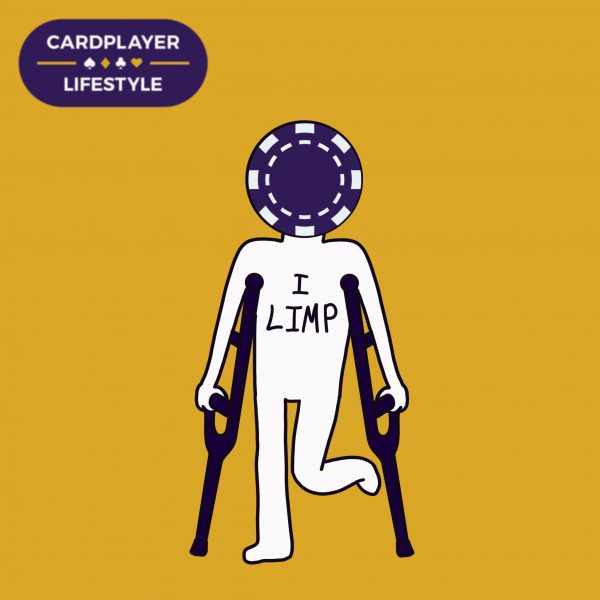The preflop action of limping in poker was a staple of 1980s and 1990s ring games such as Limit Texas Hold’em and Omaha. By limping, players in early position can commit the minimum and hope to see community cards – as long as the action is not raised preflop by one of the players seated to their left.
However, as poker moved online in the early 2000s (and as “No Limit” surpassed “Limit” Texas Hold’em games in popularity), the act of limping in poker gradually became less common – especially in full ring (9 or 10-handed) games.
Preflop limping from early position with mediocre starting cards – especially in “No Limit” formats – became something that Under the Gun poker players found to be “inviting” or “donating to” other players who would gladly raise and re-raise the action before it ever got back to the original limper.
In this article, we will take a look at limping in poker, how it’s defined, and why it is not as common as it once was at full tables.

What is a Limp in Poker, and What Does it Mean?
In poker games where there is a Small Blind and Big Blind, players can “limp” before any community cards or “face-up” cards are dealt.
For example: in a $5/10 Limit Texas Hold’em game that’s 8-handed, the Small Blind and Big Blind players will contribute $5 and $10 respectively – before any cards (including hole cards) are dealt.
Once the $15 is in the pot and hole cards are distributed, the UTG (Under the Gun) player will be first to act. This player is always located to the Big Blind player’s immediate left.
In this scenario, the UTG player can raise, fold, or “call” the Big Blind amount of $10. This “calling” action is referred to as a limp.
So if the UTG player (or any other player to the left of the UTG poker position, up to the Big Blind player) decides to simply “complete” the minimum amount to remain in the hand – $10 in this case – that is known as a limp in poker.
The same terminology applies in all poker games that include a forced Blind contribution. And it is possible in this 8-handed hypothetical game for a total of seven players to limp – including the Small Blind player.
Even if all six players who act previously decide to “limp” with a $10 minimum hand contribution, the Small Blind player can simply “complete” the minimum amount (by committing another $5), and will likewise “limp” as a consequence.
The Big Blind player is the only player at the table who is NOT capable of performing a limp during the preflop stage of a poker hand. If all 7 players “limped” before the Big Blind in our $5/$10 Limit Texas Hold’em game example, the Big Blind player can either “Check” or “Raise” to remain in the hand.
A Big Blind “Check” is not referred to as a “limp” because the Big Blind player has already contributed the minimum amount (of $10 in this case).
Preflop Poker Limps Can Be Raised And Re-Raised
The main susceptibility that a preflop Limper faces is the possibility of getting raised by one of the subsequent players to act, which will force a limper (or multiple players who have limped) to either fold their hand, re-raise, or call any raises (or re-raises) that were placed by the players who acted behind them preflop.
By rule: the more players there are in a hand, the more players there will be at the table who are capable of raising or re-raising a preflop limp.
In “Limit” poker games, the amount of re-raises per phase is typically limited to four times the Big Blind amount. This means that the action can only be raised once (and re-raised twice after that) before the “cap” is enforced.
So in our 8-handed game, if the UTG player limps $10, then the UTG +1 player raises (to $20), one of the remaining players to act to re-raise (to $30), and another player – including the original UTG limper – can re-re-raise to $40.
However, once the preflop pot has been re-raised to $40 in a hypothetical Limit Texas Hold’em game described above, no more raises can be performed until the hand progresses to the next street. The remaining players in the hand have the option to either “call” the maximum, capped re-raise amount of $40 or “fold” (surrender) their hands along with any monetary contribution they had previously placed into the pot.
The wider the “raise ranges” the opponents at your table have, the more potential there will be for a preflop limp to be raised and re-raised.
A “tight” poker table (meaning that the overall “action” preflop hole card ranges for the players is stricter) may justify an early position player “limping” with relatively weak hole cards.
A UTG player with 7s-5s in a $5/$10 Limit Texas Hold’em game may be correct in limping if the chances are higher than usual that this player will get to see a flop (three community cards) without getting raised and re-raised.
But if the same table features opponents that have a much looser “raise” and “re-raise” range, this same UTG player will face a greater possibility of being forced to commit more chips to the pot preflop in order to see more cards.
An early position poker player with 7s-5s who limps $10 may feel forced to give up on the hand (a.k.a., “fold”) if subsequent players to act preflop have raised and re-raised the action up to $30 or $40 by the time the action returns to that player’s position.
And if the early position limper wishes to remain in the hand, it will correspondingly “cost” that player the full amount of the re-raises (up to a maximum cap of $40 – or $30 more than the original limp) to continue competing for the pot.
Preflop Limps Can Face Unlimited Re-Raises in No Limit Poker Games
The stark contrast between a preflop limp amount and the monetary re-raise potential becomes much more exacerbated in “No Limit” poker games. This presents a whole different slice of poker strategy to master.
In a $5/$10 “No Limit” Texas Hold’em game (with an assumed $2,000 maximum buy-in “cap” or “limit” per player) a preflop limper could theoretically face an “all-in” raise equaling $2,000 – meaning that original limper would be forced to contribute his or her entire chip stack (up to another $1,990) into the pot in order to “chase” the original $10 limp.
Limping in Poker May Invite Raises
Depending on the scenario, a preflop “limp” may entice opponents to “raise” the action in order to win not only the Blinds, but also the limped amount. This is one reason why limping in poker has decreased in popularity over time, as poker players have expanded their preflop action range to isolate any limper(s).
Let’s explore a somewhat clear-cut example of why early position players may decide to simply “fold” (or even “raise”) rather than call – or limp – the action preflop.
Let’s say we’re at a final table of a major live tournament, and the action is 6-handed. All players at this final table are guaranteed to “cash” for an amount that greatly exceeds their original tournament buy-in, but the “pay jumps” are extremely top-heavy.
1st Place: $500,000
2nd Place: $250,000
3rd Place: $120,000
4th Place: $70,000
5th Place: $40,000
6th Place: $20,000
Five of the players at the table are short-stacked, while one of the players possesses more than half the chips in play. That one player with the chip lead is currently in the Button position when a hand begins – and the Blinds are T500k/T1m with a forced T200k per-player ante per hand.
So before ANY cards are dealt, there is a total of T2.7m chips already in the pot.
UTG: posts ante (200k) – total remaining chips = 20m
UTG +1: posts ante (200k) – total remaining chips = 20m
Cutoff: posts ante (200k) – total remaining chips = 20m
Button: posts ante (200k) – total remaining chips = 200m
Small Blind: posts ante (200k), posts SB (500k) – total remaining chips = 19.5m
Big Blind: posts ante (200k), posts BB (1m) – total remaining chips = 19m
In this scenario, early position poker players may be discouraged from “limping” into the pot with any hand other than a premium holding, because:
1. If a player behind them has a premium hand, that player is likely going “all-in,” which would likely force a “fold” from the original early position limper.
2. The player on the Button – who has most of the chips – is incentivized to broaden his or her action range because of the potential “dead money” that’s already in the pot.
So if the UTG player in this instance limps for T1m chips with 7s-5s (and the action is folded to the Button player), the player on the Button has a broad range of hands that can be raised from the Button.
And if the Button places a raise (of let’s say, T22m chips) against the original limper, then the Button player stands to capture nearly that same amount in “dead money” chips if all opponents decide to subsequently fold preflop.
The original limper, in the UTG position, with 7s-5s suited, lacking any pot odds, is pretty much forced to fold in such a scenario… unless that UTG player is willing to risk giving up a chance at a significant pay jump in a heads-up “all-in” battle against the Button player’s raise range.
Aggressive Preflop Raises Make Limping Less Popular
Again, the more aggressive of a preflop “action” range that the players at the table have, the less likely an early position player will be able to see community cards by merely “limping” into the pot with the minimum contribution that equals the Big Blind amount.
Subsequent raises versus an early position “limp” can “isolate” the original limper(s) if they decide to continue to the flop by calling the amount of a raise (or re-raise).
And with this increased likelihood of getting raised preflop comes a realization that limping preflop with a mediocre starting hand can result in simply “giving away” money.
Trapping Via Preflop Limping in Poker
Especially in No Limit poker formats, an early position player may be able to more successfully “trap” opponents by limping the action preflop in hopes of being able to entice a raise and then be able to “re-raise” the preflop hand once the action returns to that player.
As with all poker hand scenarios, it is important to be fully aware of your chip stack (relative to your opponents’ stacks), the poker game format, tournament payout tables, and other pertinent information to decipher the specific situations in which a preflop “trapping” limp will become profitable.
As one might expect, a preflop re-raise that’s put in by an original limper will send proverbial “red flags” to all remaining opponents in the hand. And if those opponents believe your “limp-then-re-raise” range is isolated to only AA and KK (in a hypothetical No Limit Texas Hold’em game), then those opponents may correctly “fold” to an all-in re-raise by the original limper if it doesn’t make mathematical sense for their hand to go all-in against that original limper’s tight re-raise range.
So in a 6-handed, $5/$10 No Limit Texas Hold’em game that has a capped maximum buy-in of $2000 – the UTG player “limps” for $10 with Pocket Aces,
The action folds to the player on the Button, who decides to raise the preflop action to $35 in hopes of winning the $25 “dead money” in the pot without a postflop battle.
The action is folded back to the original limper, who then re-raises “all-in” to $2,000 – and the Button player happily mucks a mediocre starting hand.
This is a drastic example of how an original early position limper may hope to entice a raise in hopes of having a chance to re-raise the action. But again, if that original limper’s re-raise range is limited to premium hole card starting hands, it will be MUCH easier for opponents to “isolate” that original limper’s range.
This means that if the original limper re-raises to $80 in the example explained above, the player on the Button may have a chance to simply “call” that re-raise in a way that’s profitable – because the Button player is aware that the original limper’s range is limited to AA or KK.
Summary: Limping Preflop in Poker
As long as a player is mindful of the variables that can be estimated or “ranged” while at the poker tables, it may be routinely possible for a player who’s considering a limp to figure out whether the play will be profitable or not (or how to maximize profitability when holding a premium starting hand).
Study the game, learn by experience, and use the physical and digital resources available to you such as top poker training sites to have a better grasp on when it’s appropriate to limp, and you’ll increase your expectations at the poker tables.
Best of luck at the tables!







